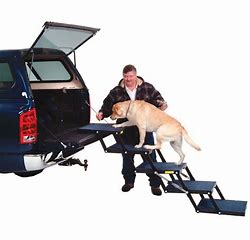
Written by: Tracie Grubb, DVM, CCRT, cVMA
Stairs vs Ramps? This is a subject that is discussed every day in veterinary rehabilitation.
When your pet needs to move from the floor to the bed, from the ground to the car, from the couch to the floor, what works best?
I’d like to share my insight and hope it helps your pet get from Point A to Point B safely.
My Point of View:
Personally, I like stairs over ramps. The ramp simply creates more stress on the body. Think about walking up a long, steep hill versus walking up a shorter hill that has a small mesa in which to rest. That, to me, is the difference. Plus, most dogs are accustomed to stairs either in the house or outside.
Whatever product you decide on, here are some things to look for and to avoid.
Steps and Ramps:
- provide a means to get from Point A to Point B.
- require training.
- have pros and cons.
PORTABLE STAIR STEPS SHOULD:
- be wide enough and deep enough for your pet. Larger dogs may require fewer steps than small dogs.
- support the weight of your pet. (Read the product specifications carefully.)
- be stable on the ground
- have a non-skid surface for your dog’s feet
- be easy to use and carry
- be easy to clean
RAMPS SHOULD:
- be easy to use and carry
- be wide (ideally, wider than shoulder width)
- have a raised, textured surface (sandpaper is not sufficient)
- support your pet’s weight (Read the product specifications carefully.)
- be easy to clean
SOLUTION:
It may take days, weeks, months to get your pet accustomed to using ANY mobility aid. Set realistic expectations for your pet. Don’t expect them to adapt overnight. Work with your dog several times per day to help them acclimate to the new item.
Start by bringing the device in to the house. Let them sniff it, walk around it, just get used to it being there. Let it become part of the furniture for awhile.
Ramps: lay them flat on the floor. Don’t prop them up on anything until your dog is comfortable.
Steps: Set them in an area where they cannot hurt themselves if they try it out. You can start next to the end of a couch near a wall or a low traffic corner of the room . Block it off when you cannot be around to supervise.
TIP: If your pet is scheduled for surgery that will limit their mobility during their recovery, start training them how to use a crate, ramp/stairs, etc… early! These are items that will be instrumental to a successful recovery. If they are not used to being in a crate, exercise pen, or have never used a ramp, these things can be scary as they are the first things they see when they return home from the hospital. Working with them early will help ease their stress.
RAMP SET UP AND USE:
Always use a leash when training on ramps (or stairs).
- Fold it out and lay it on the floor. (Be careful that you or a family member doesn’t trip over it.) Again, let them get used to it being there. Use treats to guide them over and across the flat ramp within their comfort zone. It will get easier. Always support them to prevent injury.
- Once they relax around the ramp, start moving it outside in the yard and work toward moving it in the vicinity of the car. If indoors, start moving it closer to the edge of the bed or sofa if using for furniture access.
- Prop up one end 2-4″ and let them walk over and across the ramp at a slight incline. (Smaller dogs require a lesser incline.)
- When it’s tie to work with the ramp to get in the car, be patient. Don’t rush them, and always provide support. It’s often easier if the bottom end of a ramp can be positioned on a curb to reduce the level of incline (or rise) and reduce stress on your pet’s joints and muscles.
STAIRS SET UP AND USE:
Always use a leash when training on stairs (or ramps). Your dog may try to jump over the stairs to get to the furniture and could be injured.
- Never allow them to use ANY stairs unattended until they are proficient. Use treats to guide them safely up AND down.
- Place the stairs in a protected area (in a corner where they can see it, but not use it). This is to get them used to the item being in the room.
- When they are comfortable with the presence of the item, move it toward the end of a sofa when you can be there to observe their reaction and help them.
- Do not allow them to use the stairs in one direction only. They need to learn how to use stairs both going UP and DOWN.
- The goal is to train them to slowly go up AND down to prevent injury.
- Wide and deep stairs will give them the most surface area to place their paws and increase safety and stability.
PRODUCT SUGGESTIONS:
www.petloader.com

Note: Expensive, but so well made and worth the money.
This product comes in a variety of sizes.
www.petstep.com
Note: A nice, wide and textured ramp.

